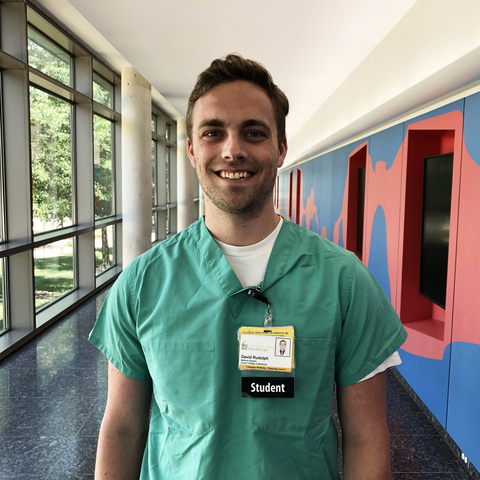
Good advice for anyone facing an important test—and exactly the self-reminders David Rudolph used to excel at Step 1 of the United States Medical Licensing Examination (USMLE) earlier this year.
Rudolph, a fourth-year student in the University of Iowa Carver College of Medicine, had the highest score among the most recent group of UI medical students taking the USMLE Step 1. His score of 272 (out of possible 300) earned the Iowa City native a $3,000 scholarship award from the college that will be applied toward medical tuition and fees.
The USMLE Step 1 is the first test in the three-exam process for medical licensure in the United States. Step 1 measures how well students can apply basic and foundational scientific concepts to clinical scenarios. The exam is divided into seven 60-minute blocks and administered in one eight-hour session. The number of randomized, multiple-choice questions per block may vary, but does not exceed 40; the total number of questions for Step 1 does not exceed 280.
It’s one of the toughest, and one of the most important, exams medical students must pass.
With the medical school curriculum here at Iowa, we get into our clinical rotations a semester early—we do a year and a half of pre-clinical and then a year of core clerkship rotations before taking Step 1 in the middle of the M3 year. The idea is that the better you do in your clerkships and the more you are exposed to clinical problems and practice, the better you will do on the Step 1.
MD students in the UI Carver College of Medicine take the USMLE Step 1 after completing their core clinical clerkships, which is typically midway through their third year.
Rudolph recently recounted his success with the USMLE Step 1:
How did you prepare for the USMLE Step 1, and what was key to your high score?
Most students at other medical schools take Step 1 after two years of pre-clinical study. With the medical school curriculum here at Iowa, we get into our clinical rotations a semester early—we do a year and a half of pre-clinical and then a year of core clerkship rotations before taking Step 1 in the middle of the M3 year. The idea is that the better you do in your clerkships and the more you are exposed to clinical problems and practice, the better you will do on the Step 1.
As such, we have eight weeks of dedicated study time [which includes the winter holiday break] at the end of the core year, and we can schedule the Step 1 for anytime in that dedicated period. I took the Step 1 test at about six weeks in. Some students take all eight weeks to prepare, and some students start to study while they’re still completing their core year.
Was the exam more difficult than you expected?
After doing so many practice questions—literally hundreds, which most students do to prepare for the test—you have a pretty good sense of what to expect. But it’s still a monster of a test, and there’s pressure that you cannot replicate in preparation.
That said, you start to get into a rhythm after the second set of 40 questions and trust the process you followed in preparing for the test.
What was your process?
There are a number of practice exams available that are like four or five hours long. I did those, and one time I added several 40-question sets on top of the practice exam just to simulate the actual all-day test.
Also, I studied the subject material on the practice questions relevant to a clinical rotation I was about to start, which helped a lot. And I made sure to attend regularly all my pre-clinical classes, which paces and reinforces the material.
What do you recall about taking the Step 1?
I took it in Hiawatha [at the nearest testing center] in late January 2019. It was the dead of winter, and eastern Iowa was experiencing the polar vortex—negative 30 degrees outside! I took it on a Friday with five other students. Having some of my peers there that day made it seem less stressful.
What advice would you give to other medical students preparing to take the USMLE Step 1 exam?
Stay calm. Every medical student takes the test, and most, if not all, pass and make it to residency training. So, in that sense, keep the big picture in mind. The more work you put into your classes—and core clerkships especially—the better you will do on Step 1. Put in the time and effort, knowing that you’re never going to know everything. You just need to have the right mindset and a good balance of confidence and humility to do your best.
What specialty most interests you for residency training?
I’m planning to go into emergency medicine. I like the pace and the decision-making that is part of emergency care, and you see a wide variety of cases and conditions.
I was an emergency medicine scribe as an undergrad at the University of Oklahoma. Scribing means working alongside a physician, observing their encounters with patients, and providing documentation that, after review, goes into the patients’ medical records. It was a steep learning curve, but I was exposed to a wide variety of medical conditions and terminology. It was a great experience for me as a pre-med student and advantageous when it came to applying to medical school.